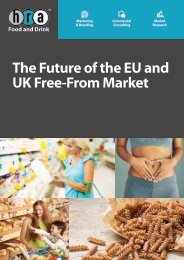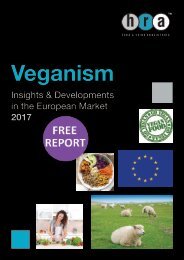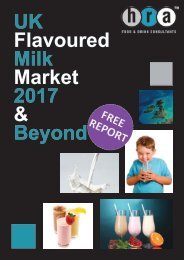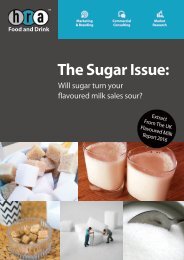European Lactose-Free Market Report 2017/2018 Report
Dying to know what’s going on in the hottest Free From category? Looking for something different to those tedious reports filled with nothing but data and no insight? Looking for detailed category analysis from experienced specialists to give your brand the ‘Edge’?
Dying to know what’s going on in the hottest Free From category?
Looking for something different to those tedious reports filled with nothing but data and no insight?
Looking for detailed category analysis from experienced specialists to give your brand the ‘Edge’?
Create successful ePaper yourself
Turn your PDF publications into a flip-book with our unique Google optimized e-Paper software.
8. CONCLUSIONS<br />
THE EUROPEAN LACTOSE-FREE MARKET <strong>2017</strong>/<strong>2018</strong><br />
§ <strong>Lactose</strong>-intolerance is a non-allergenic condition, where the consumption of<br />
lactose containing foods induces a range of digestive issues. This is caused by the<br />
inability to produce the lactase enzyme in the gut.<br />
§ The main treatment for lactose-intolerance is abstinence from dairy foods that<br />
contain high levels of lactose. Not all dairy products contain the same lactose<br />
concentrations. White milk contains high levels of lactose, whilst hard cheeses<br />
contain almost none. Goat, cow and sheep milk all contain similar levels of lactose.<br />
§ The prevalence of lactose intolerance differs across the world. Only 10% of people<br />
from Northern <strong>European</strong> descent are lactose-intolerant, whilst populations<br />
originally from South East Asia can have up to a 90% prevalence. This variation<br />
has implications for the lactose-free market, especially when considering current<br />
migration trends and export opportunities.<br />
To view, please download FULL <strong>Report</strong><br />
§ <strong>Lactose</strong>-free products are not governed by specific regulations as, say, the glutenfree<br />
sector, but are covered by a patchwork of legislation. In 2011, the <strong>European</strong><br />
Food Safety Authority (EFSA) concluded that individual tolerances to lactose differ<br />
largely, so a ‘safe’ threshold for lactose content in lactose-free food cannot be<br />
prescribed. It is up to manufacturers to decide what constitutes lactose-free, with<br />
lactose levels typically ranging from 0.1% to 0.01%.<br />
§ <strong>Lactose</strong>-free cow’s milk is produced by removing lactose through filtration and<br />
enzymatic technology. This is the same process used in sugar reduction<br />
technology. Arla, a key player in the <strong>European</strong> lactose-free market, has<br />
experienced good growth with their Lactofree range.<br />
§ Plant-based milk alternatives, such as soya, almond and hazelnut milk, are<br />
becoming more and more popular in Europe. These drinks are naturally lactosefree,<br />
but are aimed at a wide range of consumers, including vegans, consumers<br />
with milk allergies and intolerances, and people who perceive milk as being bad<br />
for health or weight. Alpro, an important company in the sector, is experiencing<br />
growth, especially in its range of luxury flavoured yoghurts.<br />
All rights reserved, ©Teepee Ltd, t/a HRA Food & Drink: <strong>2017</strong> 34







